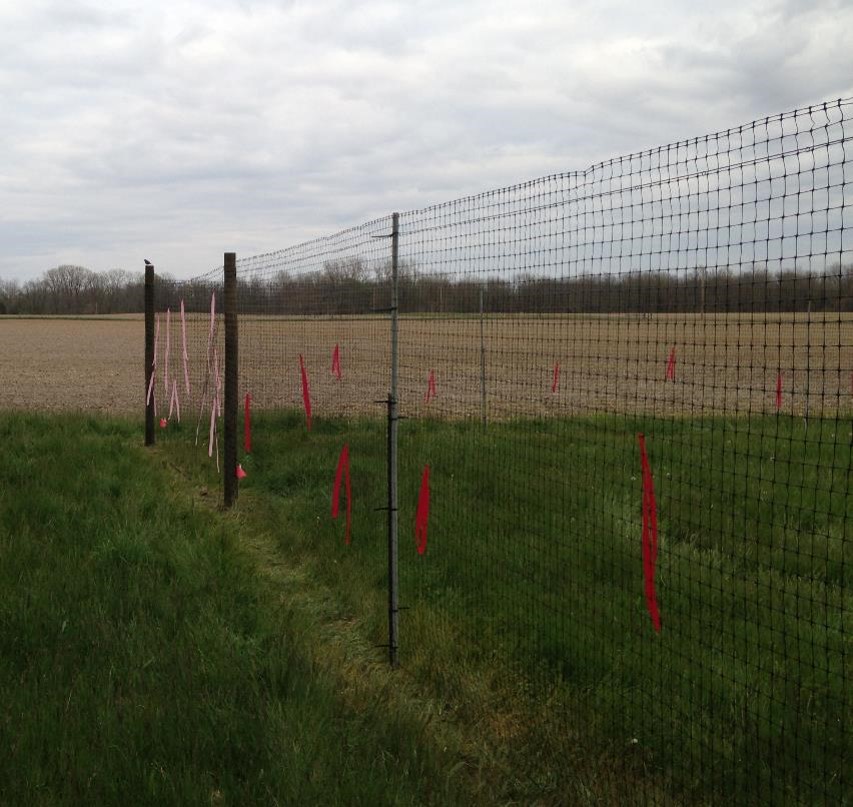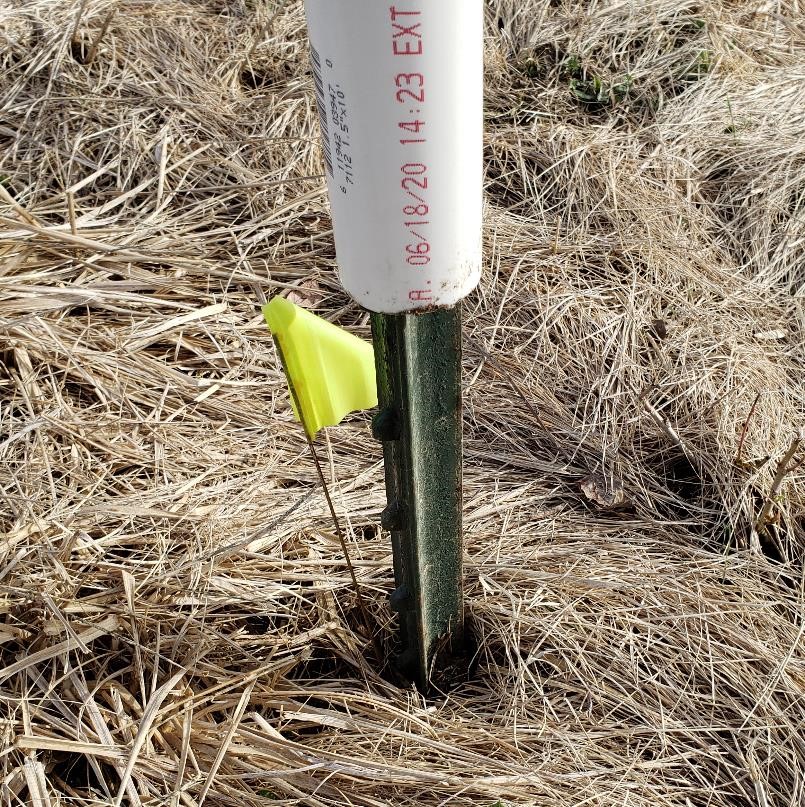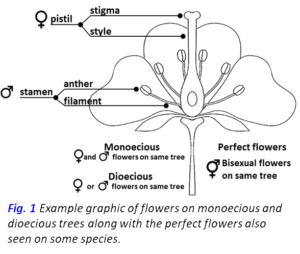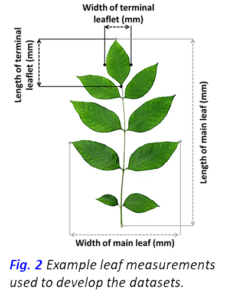HTIRC E-NEWSLETTER
Spring 2021
Volume 13 Issue 1
Articles in this issue
- Exclusion Fencing Practices Available through USDA to Enhance Tree Regeneration
- New Woodland Stewardship for Landowner Video Series
- Purdue’s Next Moves initiative will include Digital Forestry
- Dr. Keith E. Woeste Promoted to Project Leader
- Public-private partnership to conserve imperiled butternut
- Recent publication quantifies economic feasibility and potential of Timber Stand Improvement for Central Hardwood Forests
- Machine-learning as a tool for tree improvement
- Seed Propagation Protocol Developed by Drs. Brennan and Jacobs Published in Tree Planters Notes
- Dr. Mike Saunders and David Mann Publish on Prescribed Fire and Timber Quality
- HTIRC Researchers Contribute to Recommendations for Restoration of Butternut
- Guide for Production of Bare Root Hardwood Seedlings
- Recent Promotions at HTIRC
- HTIRC Graduate Students that have graduated
Exclusion Fencing Practices Available through USDA to Enhance Tree Regeneration
By Lenny Farlee, Extension Forester
USDA conservation programs provide technical and financial incentives for landowners to install and maintain conservation practices, including tree plantations. They are an important tool to help encourage landowners to make an investment in long-term activities like planting hardwood trees. Research across the eastern US, including work done by the HTIRC, demonstrates that deer browse can be one of the most significant barriers to establishment of a successful tree plantings. Deer may increase mortality, but more often they are preventing planted or naturally regenerating trees from growing in height due to repeated browsing. This damage can also deform trees, resulting in poor stem form and lower potential log quality. Plantations where deer selectively browse desirable species may lose important species like oaks due to overtopping by less favored, and therefore less browsed, species that become free to grow. Reducing the damage done by deer browse is an important, and in many locations the most critical step in successful tree planting establishment in many areas across the eastern US.

One of the primary purposes for these conservation tree plantings is developing forest wildlife habitat, but to successfully establish that habitat may require excluding deer for a few years, until the trees are tall enough to continue growing past the deer browse damage. Fortunately, many state Natural Resource Conservation Service offices are recognizing the impact that deer browse is having on establishing successful conservation tree plantings. To address this barrier to successfully establishing tree plantings and natural regeneration, new scenarios are being added to the Tree and Shrub Establishment practice:
- The “Planted Area with Protection” scenario provides cost assistance for tree and shrub planting and placement of a temporary perimeter fence to exclude deer until trees have grown above the height of deer browsing.
- The “Regeneration Area with Protection” scenario provides cost assistance for placement of a temporary fence to protect natural regeneration of tree and shrub species.

Increased cost assistance payments may be available to help offset some of the additional cost a deer exclusion fence adds to a planting project. States may have differing cost assistance rates and practice requirements. These and other additions to the NRCS tree planting practices provide landowners and natural resource managers effective tools to establish tree plantings that can produce high quality hardwood trees in the future. Check with your local foresters and NRCS offices to see if this practice is available in your area and details on payment rates and requirements. If the practice is not available, work with your local resource management contacts to request addition of this practice for your area in the future.
The HTIRC has supported this fencing practice through research and demonstration plantings that have showcased the benefits deer exclusion fencing can provide for timely establishment and timber quality development in hardwood plantings. The publication, How to Build a Plastic Mesh Deer Exclusion Fence, https://www.extension.purdue.edu/extmedia/FNR/FNR-486-W.pdf is used as a reference for deer fence construction options in Indiana and Wisconsin. We are also exploring material and construction options that can make this fence design easier and perhaps less expensive to build. We plan to release updated construction methods soon, but a preview photo of one of our construction options is included with this article.
New Woodland Stewardship for Landowner Video Series
The Indiana Department of Natural Resources Division of Forestry and Purdue Extension-Forestry and Natural Resources partnered together on the Woodland Stewardship for Landowners video series to help educate landowners on options for managing their woodlands.
This series includes videos about different forestry practices available to woodland owners, including information on their scientific basis, costs & benefits, and the general approach of each practice. This will allow woodland owners to make more informed long-term management decisions that enhance their woods for their objectives.
Videos available include: Autumn Olive, Buckthorn, Japanese barberry, Privet, EQIP, Foliar Spray. Sealed Bid Timber Sales, and Managing Deer Damage to Young Trees. More videos will be out in 2021.
View the videos.
Purdue’s Next Moves initiative will include Digital Forestry
Purdue University announced in April the launch of Purdue’s Next Moves – five new distinct strategic initiatives designed to advance the university’s competitive advantage in its continuing quest for leadership among the world’s top research and teaching institutions. Plant Sciences 2.0 will be one of the strategic initiatives and will include Digital Forestry as a major research emphasis. Led by Songlin Fei, professor and the Dean’s Remote Sensing Chair, the Integrated Digital Forestry Initiative (iDiF) at Purdue University is working towards developing platforms and strategies that leverage digital technology to measure, monitor and manage urban and rural forests to maximize social, economic and ecological benefits.
You can learn more about the areas of research and the scientists involved in Digital Forestry at:
https://ag.purdue.edu/fnr/Pages/digital-forestry-about.aspx

Dr. Keith Woeste Promoted to US Forest Service Project Leader
Dr. Keith E. Woeste was recently promoted to USDA Forest Service Project Leader for the US Forest Service portion of the Hardwood Tree Improvement and Regeneration Center, which is a unit of the USFS Northern Research Station. Dr. Woeste has been a Research Plant Molecular Geneticist with the HTIRC since its inception. Dr. Woeste studies the genetics of forest trees including the development and use of DNA markers and DNA sequence data to understand the genetic variability of forest resources, the evolution and spatial distribution of that variability, and the breeding and selection of trees for plantations and for species restoration.
Dr. Woeste earned his B.S., Botany in 1980 at the University of Florida. He earned a M.Div., Theology in 1986 from the Jesuit School of Theology, Berkeley, CA. He received an M.S., Horticulture in 1990 and a Ph.D., Genetics in 1995 from the University of California, Davis, CA. He did Post-doctoral Studies from 1995 – 1998 at the University of Illinois, Chicago, IL.
Significant accomplishments include development and application of nuclear microsatellites for genetic analysis in walnuts, in collaboration with Dr. Michael Ostry, the establishment and maintenance of largest and most comprehensive germplasm repository for the threatened species American butternut, collaboration with Paul Berrang to establish USDA Forest Service Region  9 butternut seed source tree testing orchard, development of SSRs (simple-sequence repeats) for study of genetic diversity of Geosmithia morbida, the fungal component of Thousand Cankers Disease of walnut. Breeding research is focused on improvement of fine hardwoods, including black walnut, black cherry, red oak and white oak.
9 butternut seed source tree testing orchard, development of SSRs (simple-sequence repeats) for study of genetic diversity of Geosmithia morbida, the fungal component of Thousand Cankers Disease of walnut. Breeding research is focused on improvement of fine hardwoods, including black walnut, black cherry, red oak and white oak.
Public-private partnership to conserve imperiled butternut
Bedford, Ind., October 26, 2020 — In 2012, USDA Forest Service staff from the Hoosier National Forest (HNF), the Eastern Region National Forest genetics program, the Northern Research Station (NRS), and the Hardwood Tree Improvement and Regeneration Center (HTIRC) at Purdue planted approximately 60 grafted butternut trees in a seed orchard as part of a larger effort by the Forest Service to conserve the species and to breed resistance to butternut canker disease which has been killing this species throughout its native range for over 40 years. Butternut (Juglans cinerea) is a tree in the walnut family known for its excellent nut production and timber quality. A great food-producer for wildlife, its wood is also prized for its soft, easily worked nature, patterned grain, light cinnamon color and satin-like polishing capability. They were also heavily utilized by Native Americans and early settlers for their nutritional and medicinal properties. The number of butternut trees has continued to decline and outside of several locations it no longer regenerates naturally in the United States making it functionally extinct. It is currently listed as endangered in Canada, and in the U.S. has a conservation status of either critically imperiled (S1), imperiled (S2), or vulnerable (S3) in 21 states.
The seed orchard planted in 2012, and added to in 2013, is a partnership between the HNF, the USDA Forest Service NRS and a private furniture manufacturing company located in Huntingburg, Indiana, Office Furniture Systems (OFS Brands). In keeping with OFS’s long history of promoting forest stewardship, they provided the location to establish the butternut seed orchard – a large, open area with plenty of sun and little concern about predation from deer, squirrels, etc. They also keep the area mowed and have even watered the trees when there has been drought. Hoosier National Forest staff monitor and care for the trees, as well as collect the seeds annually. Research teams in the NRS / HTIRC have focused on the pathology of butternut canker disease, the conservation genetics of butternuts, the identification of butternut habitat, and the propagation of butternut seed orchards to supply seeds for National Forests and the American public. For more information on current research visit https://doi.org/10.3389/fpls.2020.580693.
The butternut trees in this OFS / HNF orchard were all collected from healthy living trees in southern Indiana; some from the HNF itself and others on private forests. Even a few southern Ohio trees were included as a similar orchard for the Wayne NF was concurrently created. Currently, the HTIRC and the Indiana Department of Natural Resources, Division of Forestry are developing resistant hybrids through classical breeding at Purdue University and the Vallonia State Nursery. National Forests have created regional pure butternut seed orchards across the northeast region to conserve the species for future restoration. In early October, Hoosier National Forest staff collected butternut seeds for the ninth time. The 300 pounds of nuts were taken to the Indiana Division of Forestry’s Vallonia State Nursery, where the HTIRC staff will pick them up, hull them, and send them out to nurseries to grow seedlings. “Maintaining biodiversity in the central hardwoods region is very important. We’d hate to lose a species as important to wildlife and people as the butternut. We’re grateful to have the opportunity to partner with OFS, which allows us to propagate them in a cost-effective manner,” said Chris Thornton, ecosystems program manager for HNF.
Landowners interested in growing butternuts should be aware that currently no pure butternut is proven to be canker resistant long-term. Some selections are promising, but more testing is required to confirm disease resistance as the oldest screening tests are now just 18 years old. Note that the Indiana Division of Forestry has been selling hybrid butternuts for more than 10 years in Indiana which have proven more resistant to butternut canker disease. Most recently, the Forest Service and HTIRC researchers have found site differences dramatically affect butternut canker disease. Upland sites can be very suppressive to disease while bottomland sites can have severe disease pressure leading to cankers on every tree and 10 to 20% mortality within 15 years.
Butternut is shade-intolerant, so it must be in the main canopy to survive and grow, and they need full sunlight to regenerate. Seedlings are available to the Hoosier National Forest, private landowners and others interested in re-establishing this important species to the native woodlands of Indiana. Next spring, the 2019 seed crop will be available from Clements Nursery, West Virginia Division of Forestry.
U.S. Forest Service: (812) 277-6877 – cell
Hoosier National Forest Marion.Mason@usda.gov
811 Constitution Ave. Facebook: www.facebook.com/HoosierNF/
Recent publication quantifies economic feasibility and potential of Timber Stand Improvement for Central Hardwood Forests
Yangyang Wang, Postdoctoral Research Associate of Forest Advanced Computing and Artificial Intelligence Lab
Timber stand improvement (TSI) has been acknowledged as an effective forest management approach to improve stand productivity and quality, sustain the supply of timber resources, enhance landowners’ financial benefits, and secure critical ecosystem services. TSI is, by and large, an economic measure. However, its economic potential and feasibility remained unquantified in the Central Hardwood Forest (CHF), especially when integrated with voluntary conservation incentive programs. The objective of this study was to examine TSI as an investment tool in hardwood forests for Non Industrial Private Forest landowners (NIPFs).
Our recent publication in Forest Science reveals that by the end of 2046, on average, TSI would boost the economic value of sawtimber on the residual stand by approximately 25% in the study region, the White River Basin, relative to the unmanaged baseline. By 2046, TSI would improve the timber value of the residual stand by $913/acre (Table1). Aided by the Classified Forest and Wildland Program and Environmental Quality Incentive Program (EQIP), TSI could also generate a positive net present value (NPV) simply from TSI thinning activities, making TSI an economically sustainable practice. In particular, participation in the EQIP could, on average, boost the NPV of timber income from thinning activities by nearly $648 per acre over a course of 30 years for the eligible NIPF landowners (Table1).
In conclusion, this study suggests that TSI would serve as an effective management tool for central hardwood forests. Our findings verify the importance of voluntary conservation incentive programs in improving timberland quality and in enhancing TSI’s financial appeal to NIPF landowners. In particular, the EQIP could significantly reduce the costs, making the investment in TSI potentially quite profitable. The spatial analysis reveals that there exists high spatial heterogeneity in TSI benefits and impacts, suggesting that public incentive programs should be spatially targeted to achieve greater efficiency (Figure 1).
Classified Forest and Wildlands Program (CFW): https://www.in.gov/dnr/forestry/programs/
Environmental Quality Incentive Program (EQIP): https://www.nrcs.usda.gov/wps/portal/nrcs/main/national/programs/financial/eqip/
Table 1. The average and standard deviation (in parenthesis) of sawlog volume (m3/ha), timber value ($/acre) of the residual stand, and net present value (NPV, $/acre) of harvested sawtimber from stand improvement (TSI) under three incentive scenarios in the White River Basin (WRB). B and C under the NPV represented the present value of benefit and cost, respectively. An annual interest rate of 6% was used. All values were in 2016 dollar.
| 2016 | 2026 | 2036 | 2046 | |||||
| VOLnoSI | 83(62) | 90(54) | 96(48) | 101(45) | ||||
| VOLSI | -6(13) | 20(24) | 23(34) | 25(42) | ||||
| HAVSI | 8 (9) | 7 (9) | 7 (8) | 7 (7) | ||||
| TVnoSI | 2,628
(2,412) |
2,970
(2,154) |
3,305
(2,044) |
3,604
(2,024) |
||||
| ∆TV | -74
(432) |
+719
(747) |
+802
(879) |
+913
(1,096) |
||||
| NPV of Scenarioa | 2 (195)
(B:164; C:162) |
21 (253)
(B:190; C:169) |
29(295)
(B:234; C:206) |
32(315)
(B:259; C:227) |
||||
| NPV of Scenario2b | 41(204)
(B:176; C:135) |
50(265)
(B:198; C:147) |
60(310)
(B:244; C:184) |
64(330)
(B:269; C:205) |
||||
| NPV of Scenario3c | 314(236)
(B:433; C:119) |
550(359)
(B:728; C:179) |
655(423)
(B:862; C:207) |
675(440)
(B:894; C:219) |
||||
VOLnoSI: sawlog volume without TSI by the end of every ten years.
VOLSI: change in sawlog volume due to TSI by the end of every 10 years.
HAVSI: harvested sawlog volume through TSI.
TVnoSI: timber value of the residual stand without TSI.
∆TV: change in timber value of the residual stand due to TSI.
a No financial assistance received for TSI.
b Participation in the Classified Forest and Wildlands (CFW) program.
c Receiving cost-share assistance from the Environmental Quality Incentives Program (EQIP).

Figure 1. The net present value of stand improvement (TSI) investments for three incentive scenarios in the White River Basin (WRB), Indiana, under scenario RCP8.5. Scenario 1 was the base scenario with no public financial assistance; Scenario 2 represented participation in the CFW program; Scenario 3 denoted the receipt of a flat-rate cost-share assistance provided by EQIP. The number of plots in each subpanel represented the number of FIA sample plots that were due for TSI in the attendant incentive scenario.
Reference:
Wang, Y.Y., Ma, W., Farlee, L.D., Jackson, E.A., Shao, G.F., Ochuodho, T., Liang, J.J., Zhou, M. 2021. Assessing the Benefits and Economic Feasibility of Stand Improvement for Central Hardwood Forests. Forest Science. fxaa057, https://doi.org/10.1093/forsci/fxaa057
Machine-learning as a tool for tree improvement
In November of 2017, the HTIRC newsletter featured several cutting-edge techniques (RNA sequencing, RNAseq; Laser-capture microdissection, (LCM); and Genome-wide association study (GWAS)) used by the graduate students within the group. In this article, the technique of machine-learning will be presented. Dr. Shaneka Lawson has been working with International collaborators to evaluate machine learning to accurately predict sex in immature dioecious (trees have male or female flowers) tree species. For generalreference, the most popular trees investigated by the HTIRC (oak, chestnut, walnut) are monoecious thus having male and female organs on the same tree. Several other popular species within HTIRC (poplar, cherry) are monoecious with perfect (having male and female parts on the same flower) flowers (Fig. 1).
 The applications of machine learning to breeding to obtain accurately predicted sex based on modeling and basic morphological traits is tremendous. Considerable financial resources could be preserved and greater profit margins could be realized for those interested in pursuing a cash crop like fruit or nut trees. Examples of dioecious species include aspen, apple (some exceptions exist), boxelder, cedar, ginkgo, holly, kiwifruit, mulberry, Osage orange, pear, persimmon, pistachio, red cedar, white ash, and willow.
The applications of machine learning to breeding to obtain accurately predicted sex based on modeling and basic morphological traits is tremendous. Considerable financial resources could be preserved and greater profit margins could be realized for those interested in pursuing a cash crop like fruit or nut trees. Examples of dioecious species include aspen, apple (some exceptions exist), boxelder, cedar, ginkgo, holly, kiwifruit, mulberry, Osage orange, pear, persimmon, pistachio, red cedar, white ash, and willow.
Machine learning requires data input from a number of trees within the study. For example, the latest study uses a collection of measurements taken from leaves to create a data set with hundreds of data points. Data were collected from more than 900 leaves representing 45 genotypes before sexual maturation. The ratio of length-to-width of a main leaf (LW1) and the ratio of length-to-width of terminal leaf (LW2) were the measurements taken to generate the data sets. It is important to note that the more measurements you have, the better the dataset (Fig. 2). A subset of measurements were randomly examined using a computer program and it was shown that only two morphological leaf traits were needed to obtain 84% accuracy in sex determination, a number that was confirmed when the trees matured and their observed sex crosschecked with computer predictions.
the ratio of length-to-width of terminal leaf (LW2) were the measurements taken to generate the data sets. It is important to note that the more measurements you have, the better the dataset (Fig. 2). A subset of measurements were randomly examined using a computer program and it was shown that only two morphological leaf traits were needed to obtain 84% accuracy in sex determination, a number that was confirmed when the trees matured and their observed sex crosschecked with computer predictions.
Another machine learning project involved using measurements taken from walnut trees and nuts to predict fill percentages and kernel quality. This work has just been completed and, unlike the 84% accuracy in prediction of sex, 99% prediction accuracy was obtained with this project. Models based on machine learning can be developed for a number of other topics with the addition of more complete and universal data sets and an updated machine pipeline. Machine learning pipelines take raw data values and create an automated workflow consisting of sequential steps that apply weighted equations to raw data and generate output (Fig. 3). Models can be applied universally to walnut genetic improvement across genotypes or towards other walnut orchard management issues.

Figures by Dr. Shaneka Lawson
The original research is outlined in these articles:
Rezaei M, Rohmani A, Heidari P, Lawson SS. 2021. Using soft computing and leaf dimensions to determine sex in immature Pistachia vera L. genotypes. Measurement (https://doi.org/10.1016/j.measurement.2021.108988)
Rezaei M, Rohmani A, Lawson SS. 2021. Using an adaptive neuro-fuzzy interface system (ANFIS) to estimate walnut kernel quality and percentage from the morphological features of leaves and nuts. (Submitted)
Seed Propagation Protocol Developed by Drs. Brennan and Jacobs Published in Tree Planters Notes
Doctors Andrea Brennan and Doug Jacobs have published a detailed protocol for propagating butternuts and hybrid butternuts from seed in the publication Tree Planters Notes. This protocol will assist nursery managers, researchers, and landowners working with the endangered native butternut, Juglans cinerea, and hybrids of butternut and Japanese walnut, Juglans ailantifolia with production of seedlings from seed. These protocols will help to effectively utilize a limited quantity of seed in breeding and restoration programs.
The full protocol is available here: SeedPropagationProtocol.pdf (htirc.org)
Dr. Mike Saunders and David Mann Publish on Prescribed Fire and Timber Quality
Results from a research team including Dr. Mike Saunders and David Mann was recently published in the Journal of Forestry. This research project investigated the impacts on prescribed fire on timber quality in oak-dominated stands. Fire is an important tool in managing and regenerating oak on the landscape, but managers and landowners may have concerns about the impacts of fire on timber quality.
Read the full article, written by Wendy Mayer, Communications Coordinator for Purdue University Department of Forestry and Natural Resources here: Saunders Looks at Impacts of Prescribed Fire on Quality, Economic Value (purdue.edu)
HTIRC Researchers Contribute to Recommendations for Restoration of Butternut
Researchers, including HTIRC scientists, recently published a blueprint for restoring butternut in North American forests. A quote from the manuscript describes the project:
“In July 2019, geneticists from the United States and Canada met at Purdue University to discuss the prospects of resistance breeding for butternut. From this effort, a modified backcross breeding plan was developed. This plan begins with genetically confirmed hybrids that have butternut chloroplasts, interplanted with genetically confirmed butternut to provide pollen for backcrosses to the hybrid trees. This backcross approach to breeding (or facilitated breeding in this case) has been used extensively in American chestnut (Castanea dentata) to achieve a genome with greater than 90% C. dentata. The long-term goal for butternut is to conserve as much native germplasm as possible, introducing genes for resistance from Japanese walnut and allowing natural selection to remove susceptible trees. Naturally occurring hybrid trees bear seed abundantly, and the successful survival to maturity of naturally occurring backcrosses suggests that the nuts borne on hybrid parents are viable and competitive in situations in which butternut regeneration is favorable.”
The publication citation and link are included below.
Pike C, M. Williams, A. Brennan, K. Woeste, J.J. Jacobs, S. Hoban, M. Moore, J. Romero-Severson. 2020. Save our Species, a blueprint for restoring butternut (Juglans cinerea) across North America. J. of Forestry. fvaa053, https://doi.org/10.1093/jofore/fvaa053
Guide for Production of Bare Root Hardwood Seedlings
The Reforestation, Nurseries and Genetic Resources website has numerous resources available for those planning and implementing tree plantings. There are also references available for nursery managers and others interested in tree seedling production. The Nursery Guide for Production of Bareroot Hardwoods is now available online at the rngr.net site and a printed version is also available. A Nursery Guide for the Production of Bareroot Hardwood Seedlings — Reforestation, Nurseries and Genetics Resources (rngr.net)
Dr. Carolyn Pike, Area Regeneration Specialist for the Northeastern Area, US Forest Service and attached to the Hardwood Tree Improvement and Regeneration Center, is the Coordinating Editor for this publication.
Recent promotions at HTIRC (Congratulations)
 Dr. John Couture promoted to the rank of Associate Professor with tenure.
Dr. John Couture promoted to the rank of Associate Professor with tenure.

Dr. Mo Zhou promoted to the rank of Associate Professor with tenure.
HTIRC Graduate Students that have graduated (Congratulations)
 Madeline Montague, MS graduated March 22, 2021.
Madeline Montague, MS graduated March 22, 2021.

Andrea N. Brennan. Project Assistant, Morton Arboretum, Lisle, IL graduated August 19, 2020.
